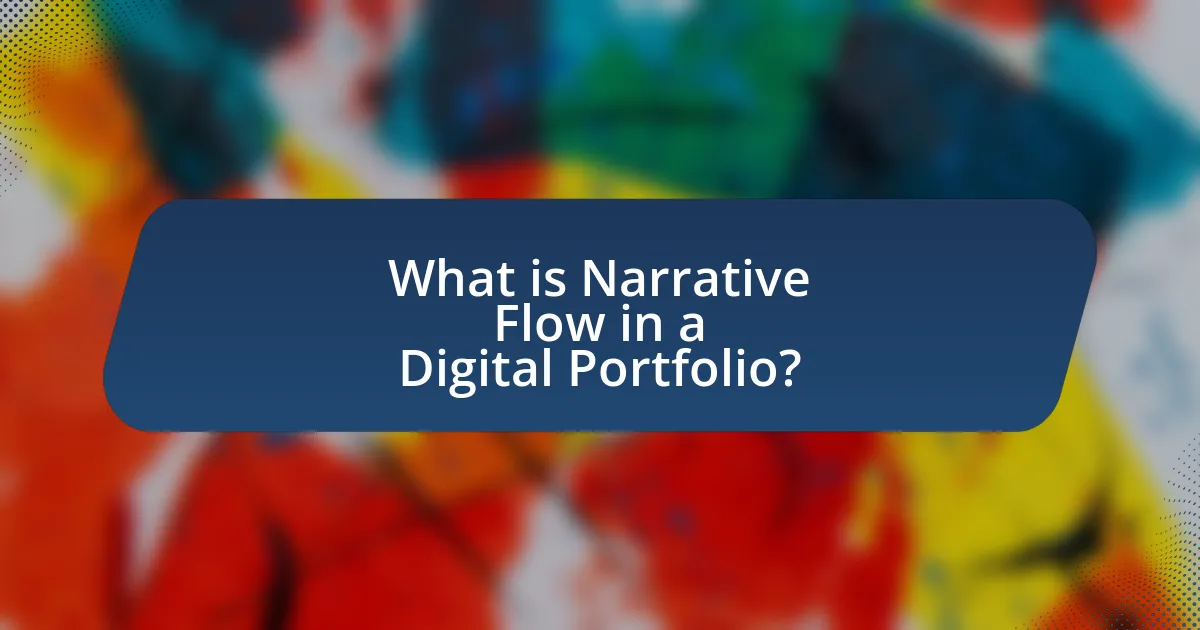The article focuses on creating a narrative flow in digital portfolios, emphasizing its importance for engaging viewers and effectively showcasing skills and experiences. It outlines key elements of narrative flow, such as structure, pacing, character development, and thematic coherence, which enhance user engagement and comprehension. The article also provides practical steps for establishing narrative flow, including content organization, visual integration, and maintaining consistency in tone. Additionally, it highlights common mistakes to avoid and best practices for keeping the narrative relevant and impactful.

What is Narrative Flow in a Digital Portfolio?
Narrative flow in a digital portfolio refers to the coherent and engaging progression of content that guides viewers through the portfolio’s story. This flow is essential for creating a seamless experience, allowing the audience to understand the creator’s journey, skills, and achievements in a logical sequence. Effective narrative flow often incorporates elements such as thematic organization, visual storytelling, and strategic transitions, which collectively enhance the viewer’s comprehension and emotional connection to the work presented.
How does narrative flow enhance a digital portfolio?
Narrative flow enhances a digital portfolio by creating a cohesive and engaging storytelling experience that guides viewers through the content. This structured progression allows potential employers or clients to easily understand the creator’s journey, skills, and accomplishments. Research indicates that portfolios with a clear narrative structure can increase viewer retention and engagement, as they facilitate emotional connections and contextual understanding of the work presented. For instance, a study by the University of Southern California found that narratives in presentations significantly improved audience recall and interest, demonstrating the effectiveness of narrative flow in enhancing communication and impact.
What are the key elements of narrative flow?
The key elements of narrative flow include structure, pacing, character development, and thematic coherence. Structure refers to the organization of the narrative, typically involving a beginning, middle, and end, which helps guide the audience through the story. Pacing controls the speed at which the narrative unfolds, influencing tension and engagement. Character development involves creating relatable and evolving characters that resonate with the audience, enhancing emotional investment. Thematic coherence ensures that the narrative conveys a consistent message or theme, tying together various elements and enriching the overall experience. These elements work together to create a compelling and immersive narrative flow that captivates the audience.
How does narrative flow impact user engagement?
Narrative flow significantly impacts user engagement by guiding the audience through a cohesive and compelling story. A well-structured narrative flow maintains user interest, as it creates a logical progression that enhances understanding and emotional connection. Research indicates that users are more likely to stay engaged with content that presents information in a clear, sequential manner, as it reduces cognitive load and facilitates retention. For instance, a study published in the Journal of Interactive Marketing found that narratives with strong flow increased user retention rates by up to 30%, demonstrating the effectiveness of narrative flow in capturing and maintaining audience attention.
Why is narrative flow important for showcasing work?
Narrative flow is important for showcasing work because it enhances the viewer’s understanding and engagement with the content. A well-structured narrative guides the audience through the work, making it easier to follow the progression of ideas and concepts. Research indicates that narratives can improve retention and comprehension; for instance, a study published in the journal “Cognitive Science” found that stories are more memorable than non-narrative information, as they create a mental framework for the audience to connect with the material. This structured approach not only captivates the audience but also effectively communicates the creator’s intent and the significance of the work.
How does narrative flow influence the perception of skills?
Narrative flow significantly influences the perception of skills by structuring information in a coherent and engaging manner. When skills are presented within a well-organized narrative, it enhances understanding and retention, making the skills appear more relevant and applicable. Research indicates that storytelling techniques can improve cognitive processing, as demonstrated in studies like “The Science of Storytelling” by Paul Zak, which shows that narratives can increase emotional engagement and memory retention. This emotional connection can lead to a more favorable perception of the individual’s skills, as the audience is more likely to remember and value the skills presented in a compelling narrative context.
What role does storytelling play in a digital portfolio?
Storytelling plays a crucial role in a digital portfolio by creating an engaging narrative that connects the viewer to the creator’s work and experiences. This narrative helps to contextualize projects, making them more relatable and memorable for the audience. Research indicates that stories enhance information retention; for instance, a study by Paul Zak found that narratives can increase engagement and empathy, leading to a deeper understanding of the creator’s skills and values. By weaving personal anecdotes and professional milestones into the portfolio, the creator can effectively showcase their journey, making the portfolio not just a collection of work, but a compelling story that resonates with potential employers or clients.

How can you create a narrative flow in your digital portfolio?
To create a narrative flow in your digital portfolio, structure your content to tell a cohesive story about your skills and experiences. Begin with a clear introduction that outlines your professional journey, followed by sections that highlight key projects or achievements in a logical sequence. Use consistent visual elements and design to guide the viewer’s eye, ensuring that each section transitions smoothly into the next. For instance, incorporating timelines or thematic categories can enhance the narrative structure. This approach not only engages the audience but also reinforces your personal brand, making it easier for potential employers or clients to understand your unique value proposition.
What steps should you follow to establish narrative flow?
To establish narrative flow in your digital portfolio, follow these steps: first, define a clear structure that includes an introduction, body, and conclusion. This structure helps guide the audience through your narrative. Next, use cohesive transitions between sections to maintain continuity and enhance readability. Additionally, incorporate storytelling techniques, such as character development and conflict resolution, to engage the audience emotionally. Finally, ensure that your visuals and text complement each other, reinforcing the narrative rather than distracting from it. These steps are essential for creating a compelling and coherent narrative flow that effectively communicates your message.
How do you identify your core message?
To identify your core message, clarify your primary purpose and audience. Begin by defining what you want to communicate and who will receive the message. This involves reflecting on your values, goals, and the unique perspective you bring to your work. For instance, if your digital portfolio showcases your design skills, your core message might center around creativity and innovation in design. Research indicates that a well-defined core message enhances audience engagement and retention, as seen in studies on effective communication strategies. By focusing on these elements, you can distill your core message into a concise statement that resonates with your audience and aligns with your overall narrative flow.
What techniques can you use to structure your content?
To structure your content effectively, utilize techniques such as outlining, using headings and subheadings, and incorporating bullet points. Outlining helps organize ideas logically, ensuring a clear progression of thoughts. Headings and subheadings break content into digestible sections, enhancing readability and guiding the audience through the narrative. Bullet points allow for concise presentation of key information, making it easier for readers to grasp essential points quickly. These techniques are supported by research indicating that well-structured content improves user engagement and comprehension, as highlighted in studies on digital communication effectiveness.
How can visuals support narrative flow?
Visuals can support narrative flow by enhancing comprehension and engagement, allowing audiences to grasp complex ideas quickly. For instance, studies show that people retain 65% of information when paired with relevant visuals compared to only 10% with text alone. This retention is crucial in digital portfolios, where visuals like images, infographics, and videos can illustrate key points, break up text, and create a cohesive story. By strategically placing visuals throughout the narrative, creators can guide viewers through the content, making transitions smoother and maintaining interest.
What types of visuals enhance storytelling?
Visuals that enhance storytelling include images, infographics, videos, and animations. These types of visuals engage the audience, evoke emotions, and clarify complex information. For instance, research shows that visuals can increase retention of information by up to 65% when paired with text, as highlighted in the study by the University of Minnesota. Additionally, infographics can simplify data presentation, making it easier for viewers to grasp key points quickly. Videos can convey narratives in a dynamic way, allowing for a deeper connection with the audience. Thus, incorporating these visuals effectively supports and enriches storytelling in digital portfolios.
How should visuals be integrated into the narrative?
Visuals should be integrated into the narrative by aligning them with the story’s key themes and messages. This alignment enhances comprehension and retention, as studies show that visuals can increase information retention by up to 65% when paired with relevant text. Additionally, visuals should be strategically placed to complement the narrative flow, guiding the audience’s attention and reinforcing the message without overwhelming the text. For instance, using infographics to summarize complex data can clarify points and maintain engagement, as evidenced by research from the University of Minnesota, which found that visual aids significantly improve understanding in educational contexts.

What common mistakes should you avoid in creating narrative flow?
Common mistakes to avoid in creating narrative flow include inconsistent pacing, lack of clear structure, and failure to maintain thematic coherence. Inconsistent pacing disrupts the reader’s engagement, as varying speeds can confuse the audience about the importance of different sections. A lack of clear structure, such as not having a defined beginning, middle, and end, can lead to a disjointed narrative that fails to guide the reader effectively. Additionally, failing to maintain thematic coherence can result in a narrative that feels scattered, making it difficult for the audience to grasp the central message. These mistakes can significantly hinder the effectiveness of a digital portfolio’s narrative flow.
How can disorganization affect your portfolio’s narrative?
Disorganization can significantly undermine your portfolio’s narrative by creating confusion and hindering the clarity of your message. When a portfolio lacks a coherent structure, it becomes difficult for viewers to follow the intended storyline, which can lead to misinterpretation of your skills and experiences. Research indicates that a well-organized portfolio enhances user engagement and comprehension, while disorganized content can result in a disengaged audience, as evidenced by studies showing that 70% of users abandon websites due to poor navigation. Therefore, maintaining a clear and logical flow in your portfolio is essential for effectively communicating your professional narrative.
What are the signs of a poorly structured narrative?
Signs of a poorly structured narrative include a lack of clear progression, disjointed events, and weak character development. A narrative that does not follow a logical sequence can confuse the audience, making it difficult to understand the story’s purpose. Disjointed events disrupt the flow, causing the audience to lose interest or become disengaged. Additionally, weak character development results in characters that lack depth, making it hard for the audience to connect emotionally. These elements collectively undermine the effectiveness of the narrative, leading to a diminished impact on the audience.
How can you fix a disjointed narrative flow?
To fix a disjointed narrative flow, ensure that each section of your digital portfolio logically connects to the next. This can be achieved by using transitional phrases, maintaining a consistent tone, and organizing content thematically. For instance, if your portfolio showcases various projects, group them by type or relevance, which helps the viewer follow your journey more easily. Research indicates that coherent narrative structures enhance user engagement, as seen in studies on storytelling in digital media, which show that well-organized content retains audience attention more effectively.
What are best practices for maintaining narrative flow?
Best practices for maintaining narrative flow include establishing a clear structure, using transitions effectively, and ensuring consistency in tone and style. A clear structure, such as a beginning, middle, and end, helps guide the audience through the narrative. Effective transitions between sections or ideas facilitate smooth movement from one point to another, preventing jarring shifts that can disrupt flow. Consistency in tone and style reinforces the narrative’s coherence, making it easier for the audience to engage with the content. Research indicates that narratives with strong structural elements and cohesive transitions are more memorable and impactful, as shown in studies on storytelling effectiveness in communication.
How often should you update your portfolio to keep the narrative relevant?
You should update your portfolio at least every six months to keep the narrative relevant. Regular updates ensure that your work reflects your current skills, experiences, and industry trends. According to a survey by the Creative Group, 60% of hiring managers prefer portfolios that showcase recent work, indicating that timely updates can significantly enhance your appeal to potential employers.
What feedback mechanisms can help improve your narrative flow?
Feedback mechanisms that can help improve narrative flow include peer reviews, user testing, and structured feedback forms. Peer reviews allow writers to gain insights from colleagues, identifying areas where the narrative may be unclear or disjointed. User testing involves presenting the narrative to a target audience and observing their reactions, which can highlight sections that may confuse or disengage readers. Structured feedback forms provide specific questions that guide reviewers to focus on narrative coherence, pacing, and engagement, ensuring that the feedback is targeted and actionable. These mechanisms collectively enhance the clarity and effectiveness of the narrative in a digital portfolio.
What practical tips can enhance your digital portfolio’s narrative flow?
To enhance your digital portfolio’s narrative flow, organize content thematically to create a cohesive story. This involves grouping similar projects or experiences together, which allows viewers to easily follow your professional journey. Additionally, use clear headings and subheadings to guide the audience through different sections, making navigation intuitive. Incorporating visual elements, such as images or infographics, can also break up text and maintain engagement, as studies show that visuals can increase retention by up to 65%. Finally, ensure a consistent tone and style throughout the portfolio to reinforce your personal brand, as consistency fosters familiarity and trust with the audience.





